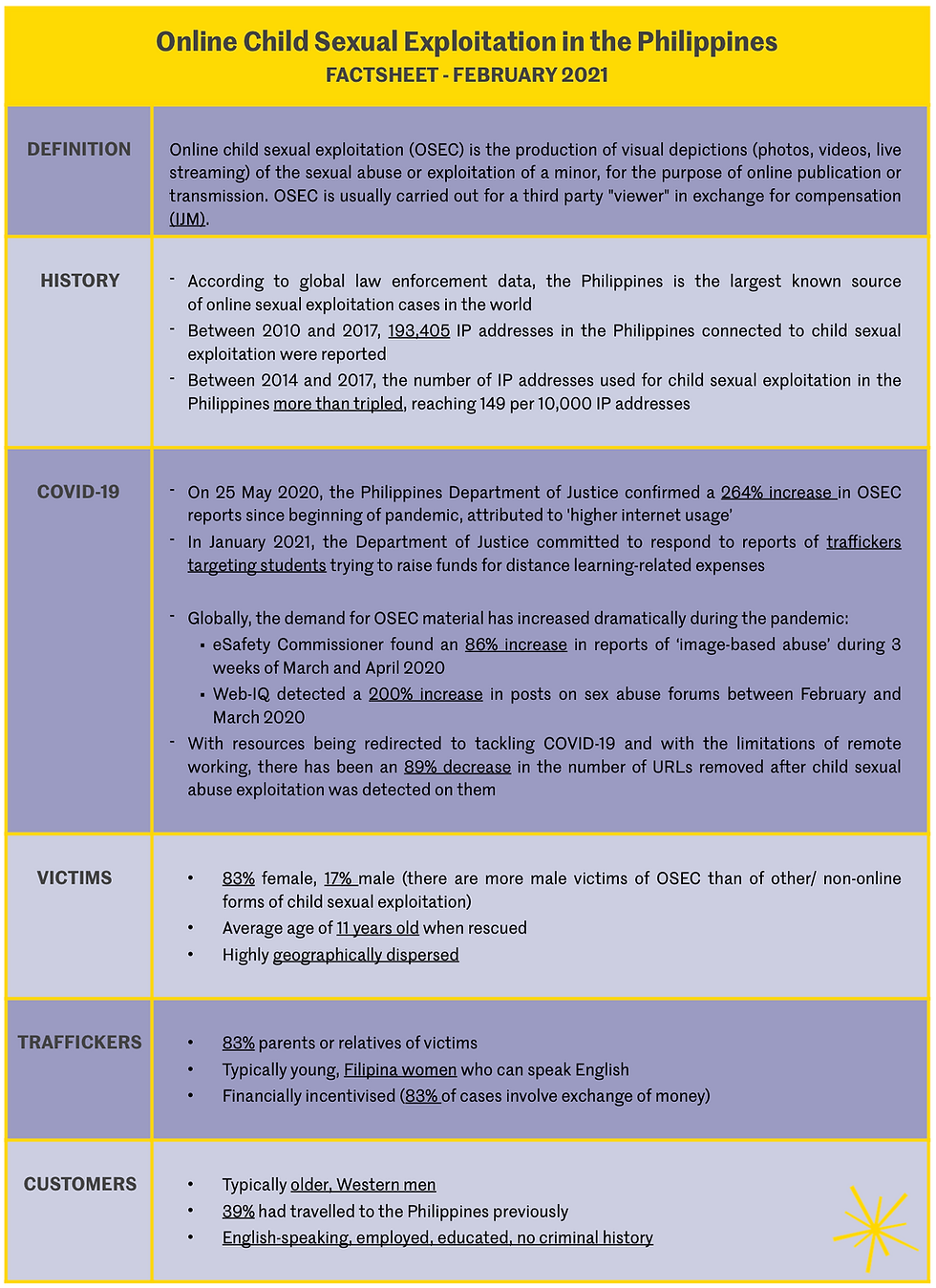Online Child Sexual Exploitation (OSEC) in the Philippines FACTSHEET
- Arise

- Feb 10, 2021
- 3 min read
Updated: Oct 13, 2021
Arise began its work in the Philippines in 2015 and opened its office in Dagupan at the end of 2020. Since then, Arise has been growing its network, while listening and learning from local anti-slavery groups.
The prevalence of slavery and human trafficking in the Philippines is inextricable from broader issues of poverty, inequality and the remittance economy. Traffickers lure people in with the promise of an opportunity (a "job" overseas or an "education" in the city) that many victims cannot afford to refuse. Migration, remittances, rural-urban inequality and resulting recruitment agencies and movement of people are all aspects of the socio-economic fabric that traffickers leverage.
Traffickers create their own "opportunities" from contexts of scarcity, capitalising on others' vulnerability. 83% of cases of online child sexual exploitation in the Philippines are carried out by family members, indicating that poverty has embedded the issue of slavery in households and communities. Responding to slavery therefore requires a comprehensive and grassroots approach. It requires providing viable alternatives to high-risk groups, through awareness, education, skills development and employment.
During COVID-19, existing vulnerabilities to trafficking have been exacerbated by rising poverty, school closures and the global "move" online. Arise's work in the Philippines is led by the experience and insight of our frontline network. Everything we seek to achieve will be with them and through them. Their reports during the pandemic have led us to look into online child sexual exploitation, what drives it, and how networks might address it as part of the broader slavery landscape.
Download the factsheet as a PDF and click on the underlined words to view their sources:

Full text:
DEFINITION
Online child sexual exploitation (OSEC) is the production of visual depictions (photos, videos, live streaming) of the sexual abuse or exploitation of a minor, for the purpose of online publication or transmission. OSEC is usually carried out for a third party "viewer" in exchange for compensation. (IJM)
HISTORY
According to global law enforcement data, the Philippines is the largest known source of online sexual exploitation cases in the world
Between 2010 and 2017, 193,405 IP addresses in the Philippines connected to child sexual exploitation were reported
Between 2014 and 2017, the number of IP addresses used for child sexual exploitation in the Philippines more than tripled, reaching 149 per 10,000 IP addresses
COVID-19
On 25 May 2020, the Philippines Department of Justice confirmed a 264% increase in OSEC reports since beginning of pandemic, attributed to 'higher internet usage’
In January 2021, the Department of Justice committed to respond to reports of traffickers targeting students trying to raise funds for distance learning-related expenses
Globally, the demand for OSEC material has increased dramatically during the pandemic:
eSafety Commissioner found an 86% increase in reports of ‘image-based abuse’ during 3 weeks of March and April 2020
Web-IQ detected a 200% increase in posts on sex abuse forums between February and March 2020
With resources being redirected to tackling COVID-19 and with the limitations of remote working, there has been an 89% decrease in the number of URLs removed after child sexual abuse exploitation was detected on them
VICTIMS
83% female, 17% male (more male victims than in other forms of child sexual exploitation)
Average age of 11 years old (younger than other child sexual exploitation victims - 19 years old)
More geographically dispersed than other child sexual exploitation victims
TRAFFICKERS
83% parents or relatives of victims
Typically young, Filipina women who can speak English
Financially incentivised (83% of cases involve exchange of money)
CUSTOMERS
Typically older, Western men
39% had travelled to the Philippines previously








Comments